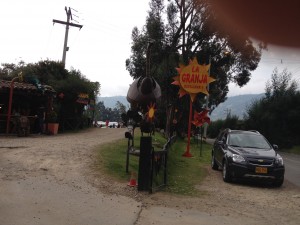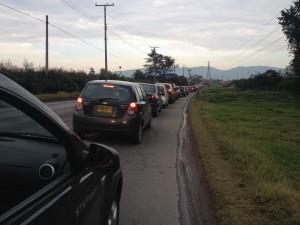On Sunday we were invited to a restaurant 16 miles outside of Bogota (roughly an hour in good traffic). It was an enjoyable mix of steakhouse/petting-zoo/children’s playground. The drive back was a new experience in frustrating; three hours to cover sixteen miles. While sitting in traffic, I took a moment to visit with a security guard; the traffic was normal for Sunday at 4:00. Our most memorable moment was back in the city. During a left turn, another car cut us off in the middle of the intersection until the traffic light changed. Sitting in an intersection, facing the wrong direction in four lanes of oncoming traffic was a new experience.
Month: February 2014
Valentines Day – Roses
80% of roses sold in the U.S. for Valentines Day come from either Colombia or Ecuador. Many are grown outside of Bogota. With the mild climate, a green house is just clear plastic stretched over a wooden frame. Their equivalent, el Dia de Amor y Amistad (Day of Love and Friendship) isn’t until September.
Nuqui – USAID

 While in Nuqui, we visited two USAID projects (US Agency for International Development). While USAID has a strong health focus in many countries, their Colombia portfolio focuses on sustainable development and human rights (http://bogota.usembassy.gov/usaid.html). At the first project, the community had built a small spa around a hot springs. When we visited, locals wanting to start small businesses in eco-tourism were finishing a class that covered operating margins, indirect costs, and fixed costs. At the second project, the river guides had created a coop to accumulate capital (dugout canoes, promotional material for the hotels, etc.) for expanding their river and waterfall tour business.
While in Nuqui, we visited two USAID projects (US Agency for International Development). While USAID has a strong health focus in many countries, their Colombia portfolio focuses on sustainable development and human rights (http://bogota.usembassy.gov/usaid.html). At the first project, the community had built a small spa around a hot springs. When we visited, locals wanting to start small businesses in eco-tourism were finishing a class that covered operating margins, indirect costs, and fixed costs. At the second project, the river guides had created a coop to accumulate capital (dugout canoes, promotional material for the hotels, etc.) for expanding their river and waterfall tour business.
Nuqui – Whales
The truly unique aspect of Nuqui are the whales. From July to October, humpback whales give birth in the sheltered waters off of Nuqui. (http://www.colombia.travel/en/international-tourist/sightseeing-what-to-do/recommended-tourist-attractions-special-reports/humpback-whales-in-the-colombian-pacific)
Nuqui – Hydropower
By default, the little hotels/cabins specialize in eco-tourism. Most are too remote to have electrical connections, A/C, etc. The cabins we stayed at relied on hydropower. The 3″ PVC pipe in the picture provided all of the power for the cabins. Water was brought from a stream sixty feet up the mountain. The water turned a paddle wheel that could drive both (1) a car alternator to provide electricity for LED lights and charging cameras/cell phones (2) a A/C compressor from a car that provided the coolant for a large refrigerator. Diverting the water through another pipe drove the blades of a modified blender for making juice.
At low tide, climbing up a rock of the coast provided limited cell phone service.
Nuqui


 We took advantage of the break at the university to go to the Pacific coast of Colombia. The Caribbean coast has an extensive tourist infrastructure. The Pacific coast remains very isolated. We went to a little stretch of coast about a 30 minute boat ride south of a town named Nuqui (pop 3,000). I’ll post a few photos, but the little hotel has better photos than I will ever take (http://pijiba.wix.com/pijibalodge#). Each hotel/cabin is very small (10-20 people max) and quite rustic (no A/C and very limited electricity). The jungle extends down to the beach, and each hotel is just a speck along the coast. At high tide, the waves reach the jungle, but low tide leaves 300-400 feet of beach.
We took advantage of the break at the university to go to the Pacific coast of Colombia. The Caribbean coast has an extensive tourist infrastructure. The Pacific coast remains very isolated. We went to a little stretch of coast about a 30 minute boat ride south of a town named Nuqui (pop 3,000). I’ll post a few photos, but the little hotel has better photos than I will ever take (http://pijiba.wix.com/pijibalodge#). Each hotel/cabin is very small (10-20 people max) and quite rustic (no A/C and very limited electricity). The jungle extends down to the beach, and each hotel is just a speck along the coast. At high tide, the waves reach the jungle, but low tide leaves 300-400 feet of beach.




